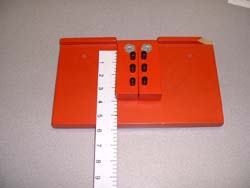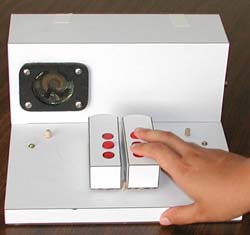Talking Dots Braille Trainer
ABSTRACT
For those with visual impairments, Braille is an essential tool for communication. However, learning Braille is difficult, especially for preschool and elementary age children. With current training devices, children quickly become bored and require constant supervision. We developed an electronic Braille training device that would improve on existing models by providing fun audio feedback and reducing the need for constant instructor oversight. The device also strengthens isolated finger movements and maintains a raised dot effect so that the user can feel the Braille patterns. A game-like flow encourages children to learn the Braille alphabet, and initial trials have demonstrated eager use by the children.
KEYWORDS
Braille; visual impairments; Braille cell
BACKGROUND
Braille is an important tool for communication for visually impaired people and it is also very difficult to learn. A therapist who works with children with visual impairments proposed a new and innovative device to assist children in kindergarten to learn the Braille alphabet. She requested the device to be similar to the Swing Cell that she currently uses to teach the children Braille. The current Swing Cell (American Printing House for the Blind, Louisville, Kentucky) teaches children how to read Braille in a 2 x 3 array (see Figure 1 top).
 |
 |
The Swing Cell can also be transformed into a 1 x 6 array (Figure 1 bottom), which corresponds to a Braille keyboard. To use this device, children place pegs in holes corresponding to the letter that the teacher or therapist requests. The problem with the current Swing Cell is that it does not motivate the children and requires constant supervision by the teacher; furthermore, the children often lose the pegs.
We developed a device that provides fun audio feedback, thus the children will not need constant direction from the teacher and they will be motivated to learn Braille. In addition, the device will use pushbuttons so that the pegs will not be misplaced. This device is an innovative way to incorporate many aspects of the current Swing Cell with new features that will improve the child's experience learning Braille. For example, if “C” were the desired letter the child wanted to type, the child would press push- buttons 1 and 3 and a response of “C, cat <meow>” would be played.
DESIGN AND DEVELOPMENT
Choosing Design Solution:
A number of different designs for the “Braille dots” were considered. The original Swing Cell structure has removable wooden pegs that act as large raised Braille dots. Optical switches could be placed within the arms of the Swing Cell at the base of each peg-hole and act as input upon insertion of the pegs. Though this was a simpler solution, therapists and instructors wanted to eliminate the pegs, because they are easily lost. Another solution is alternate action, push on – push off buttons, which would give the raised dot effect without the wooden pegs. These switches would not get lost and children would strengthen isolated finger movements by pressing the buttons.
Structural Component:
 |
A major structural consideration was production of the raised dot feeling on the swing arms. This required that the pushbuttons be flush with the surface of the arms when inactivated, and be slightly raised above the surface of the arms when activated. Furthermore, to enable the arms to swing out in the Braille writing position, the wiring between the arms and the circuitry box must allow rotation of the wires around a pivot point. Both of these requirements were met by the swing arm design and type of pushbuttons chosen. Alternate action pushbuttons were used that have a difference between the up and down position of 1/8 inch. These pushbuttons were embedded in the swing arms and a laminate cover created a smooth surface flush with the pushbuttons. On the underside of the swing arms, the path for the wires was routed close to the pivot point of the swing arms and then down through the base to the circuit box. This allowed the arms to rotate with minimal tension on the wires. Size and weight requirements were met by minimizing the circuit box and trimming length off the base below the swing arms. Several controls were mounted on the back of the circuit box to provide access only to the instructors.
Electronics / Programming Component:
We developed a custom circuit design powered through an on/off switch by a 9V DC battery source. The circuitry was based on a PIC 16F877 microcontroller programmed in C-language, an ISD4004 voice recorder chip, and an LM386 amplifier. Voltage regulators were used to reduce the 9V to 5V for the PIC and LM386 and to 3V for the ISD chip. User input from the pushbuttons and control switches goes to the PIC. When the pushbuttons are activated (raised) in a Braille configuration, the PIC determines which letter corresponds to the dot arrangement and plays back a prerecorded message corresponding to that letter. For example, if the configuration for the letter C were pressed, the message would say, “D, duck, <quack>”. A toggle switch allows users to hear the letter only or the letter and associated word / sound. The volume is controlled by a 10k W potentiometer with audio taper that is connected through an LM386 amplifier circuit to an 8 W speaker. Simultaneous pressing of the pushbuttons was enforced by including a slide-switch to control the activation timing delay within the program. In the easier setting, users are given 500ms to allow pushbuttons to be pressed and released together, and in the harder setting the delay is reduced to 200ms. The length of the delay was determined by working with certain test cases including children with impaired and non-impaired motor control. If simultaneous pressing does not happen, a message occurs indicating an incorrect entry (i.e. represents no Braille letter) or a message for another letter that was not intended. This allows children, who become accustomed to the trainer, to receive instructional prompts without the need for constant instructor oversight.
Sounds were recorded to the ISD chip from .wav files stored on a PC. In addition, the device allows the children to record their own letter-sound messages under instructor supervision.
Aesthetics:
 |
A white laminate face was used for the device to provide a smooth surface and easy recognition of pushbutton and switch positions for visually impaired users. The speaker is front-mounted to give optimal sound, and the volume control is positioned on the back of the circuit box to reduce the tendency for children to disturb other classmates by changing volumes. The timing delay switch is also on the rear of the device along with the recording buttons to avoid frustration for early users who might accidentally switch into hard mode or make unwanted recordings. The power switch and letter / letter and sound switch are located on the side of the circuit box for easy accessibility.
EVALUATION
The preliminary evaluation of the device was done with visually impaired children in pre-kindergarten to kindergarten. Therapists and instructors observed the children operating the device. Afterwards a questionnaire was given to the therapists and instructors to provide feedback and suggestions on the device.
DISCUSSION AND CONCLUSIONS
The device works as anticipated. The device allows children to learn Braille similar to the Swing Cell the students currently use. The children are able to activate a pushbutton or a combination of pushbuttons that correspond to a letter in the alphabet. The device then produces an audio response that corresponds with the letter. This allows the student to be less dependent on the instructors and provides a fun response for the children.
ACKNOWLEDGEMENTS
This project was supported by the NSF grant BES-9981867. The authors would like to thank Richard Goldberg, Kevin Caves and Diane Brauner for their assistance with the development and design of the device. A special thanks to Tim Dean who helped with the design of the casing and the mounting of the switches and pushbuttons. The authors would also like to thank Christa Wheeler and Sirin Yaemsiri for adding the record feature and designing the printed circuit board.
Author Contact Information:
Randal Cole,
University of North Carolina at Chapel Hill,
152 MacNider Hall, CB# 7575,
Chapel Hill, NC 27599,
Office
Number (919) 966-5685.
EMAIL: rcole@email.unc.edu
